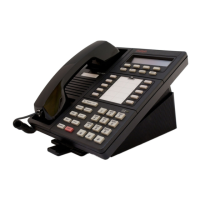MERLIN LEGEND Communications System Release 6.1
Feature Reference
555-661-110
Issue 1
August 1998
Features
Page 683Tandem Switching
Primary Rate Interface
(PRI) and T1
In Release 6.0 and later systems (Hybrid/PBX mode only), PRI and T1
(emulated tie voice or data tie) facilities can be private tandem trunks. To
provide the facility, customers order a point-to-point T1 circuit from a
service provider and use system programming to set it up for PRI or T1,
but the provider only supplies amplification, not switching services.
When system programming of the DS1 switch type labels a PRI facility as
a tandem trunk, the system selects an unused B-channel group
(beginning with Group 80 and counting backward) and assigns all the
B-channels to it. This programming can be changed after the initial
assignment.
Drop-and-insert equipment can be placed between systems connected by
tandem PRI or T1 trunks to provide fractional service. All channels still
count towards the 80-line system maximum and the PRI D-channel must
never be dropped.
PRI and T1 tandem trunks require the same initial DS1 programming
(clock synchronization, framing format, and so on) that other such
facilities do. However, for PRI facilities, routing, network service, and copy
telephone number settings are programmed automatically by the system
and cannot be changed unless the switch type is modified first.
When a call arrives on a dial-plan routed PRI facility and its digits match
an extension on the non-local dial plan, the call is routed to the
appropriate remote extension.
Remote Access Remote access allows non-local network users to access trunks
connected to the public switched telephone network, permitting cost
savings. Barrier codes are not used for this application of tandem trunks.
Instead, default tie and/or non-tie COR permissions and restrictions are
used, depending on whether private network trunks are tie trunks or PRI
facilities.
A caller can reach remote access on a networked system by calling in on
DID, PRI dial-plan routed, or dial-in tie trunks or by dialing a remote
access code programmed into the non-local dial plan. The remote system
applies any required restrictions. The barrier code requirement for the
default COR should be turned on.
A remote access caller can call a number in the non-local dial plan
Voice Messaging
Interface (VMI)
In most cases, each system in a private network should have its own
voice mail/auto attendant application. When a single system includes
both an auto attendant and all public switched telephone network trunks
that call into the application, the auto attendant application can direct calls
to non-local dial plan extensions.

